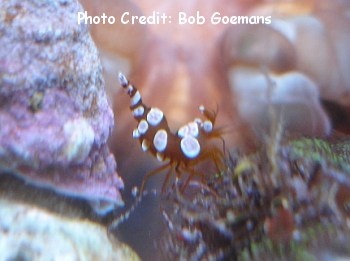
By Bob Goemans

Likely Reef Tank Suitable
Likely Fish-Only Tank Suitable
Range: All Tropical Oceans; Common in the Indo-Pacific from Eastern Africa to the Central Pacific Ocean, yet somewhat rare in Bermuda and the Caribbean.
Size: 1 inch (2.5 cm)
Natural Environment: Inhabit shallow coral reef environments receiving gentle to moderate water movement, and usually are found living in small groups between the tentacles of various sea anemones to protect themselves from predators.
General Husbandry: Fairly common in the home aquarium trade.
These non-aggressive, almost comical shrimp are commonly called Sexy Shrimp because they have a tendency to vibrate their abdomen while walking. While still, they arch their tail upwards towards their head, often shaking the tail as if sending a signal to others of their species or as a warning to predators. They can also move quite quickly when they want, e.g., can go short distances, about 4 - 6 inches (10 - 15 cm) in a blink of 'your' eye.
Even though found in the wild among anemone tentacles, thereby apparently having a symbiotic relationship with the anemone of their choice, in aquariums without anemones, they seem perfectly satisfied with similar relationships on various Zoanthid, Euphyllia and mushroom species.
No direct feeding is required, as they appear to mainly feed off the slime of corals in the aquarium. Whether or not it's the mucus or trapped organisms in the mucus they feed upon is not clear. Nevertheless, they will seek and feed upon meaty scraps that make it past other animals in the aquarium, making them good members of cleanup crews.
Since these shrimp reproduce sexually, having several in the aquarium may help increase their numbers naturally! Females are slightly larger than males, however, its almost impossible to correctly sex them by size.
Should the aquarium not have a useable anemone, then large predators such as triggerfishes, wrasses, hawkfishes, and angelfishes do not make suitable tankmates. Nor would clownfish if housed with an anemone, as the clownfish would not want others being in 'their' anemone!
Taxonomy:
Kingdom: Animalia
Phylum: Arthropoda
Class: Malacostraca
Order: Decapoda
Family: Hippolytidae
Genus: Thor
FYI: Their caramel/brownish body color with large white to pinkish spots surrounded by a thin bluish circle, along with their white eyes located on the end of short stalks, make these shrimp an attractive addition to most aquariums! Then add their amusing behavior, and Sexy Shrimps become a 'must have' for most reef aquariums!
Experience Level: Beginner
Diet: Omnivore
Temperament: Peaceful
Aquarium Environment: Reef or fish-only aquarium
Coral Safe: Yes
Fish Safe: Yes
Invertebrate Safe: Yes
Acclimation Time: Shrimp are 'very' sensitive to specific gravity/salinity changes. Therefore, be sure to adjust the bag's water to that of the aquarium in which it will be placed by slowly adding small amounts of aquarium water to the bag every few minutes. In most cases, this process should take at least 15 minutes.
Aquarium Hardiness: Moderately hardy
Calcium (Ca): 380 - 430 mg/l
Alkalinity: 2.5 - 3.0 meq/l
Phosphate (PO4): <0.05 mg/l
Magnesium (Mg): approx. 1350 mg/l (relate to specific gravity) Extremely important for molting!
Strontium (Sr) 8 - 10 mg/l
Iodine (I) Trace element additives containing iodine should be used as recommended by their makers, as iodine is also vital for the molting process.
Temperature Range: 72 - 83°F (22 - 28°C)
Minimum Tank Size: 30 gallons
Lighting: PAR ratings N/A
Water Movement: WM 1 - 2
Specific Gravity: 1.023 - 1.025
pH: 8.0 - 8.4
